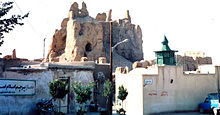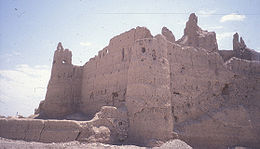- Narin Qal'eh
-
The Narin Qal'eh (In Persian: نارین قلعه) or Narin Castle is a mud-brick fort or castle in the town of Nain, Iran. Structures like these constituted the government stronghold in some of the older (pre-Islamic) towns of central Iran. Some of these castles incorporate mud bricks of the Medes period and of the Achaemenid and Sassanid dynasties.
The ruins of the structure stands 40 meters (130 ft) high from its base. Although built some 2000 years ago, it contains what seems to be a type of plumbing system made out of mortar ("sārooj") built into its massive walls. It is also peculiarly similar in design to Ali Qapu palace of Isfahan; it has a terrace high on top of the structure whose circulation is provided by two helical stair wells (whose walls have caved in, making it inaccessible). The structure also has a large underground chamber (filled now by rubble), possibly a prison. Four towers surround the entire compound, and a large gate furnishes access to a large courtyard. The structure seems to have been the victim of numerous earthquakes throughout the ages.
Some believe that the Narin castles are descendants of ancient fire-temples; some of the castles in Narin and Meybod, in Yazd province, are also called nareng castles (orange castles), possibly by folk etymology. The castle at Meybod is currently under study. Yet this castle has not been faring very well.
Unfortunately today, the ruins of Narin Gahl'eh is nothing more but the site of a local garbage dump, and what is even more depressing is that Iran contains thousands of such structures, decaying in their own rubble.
See also
- List of Iranian castles
- Iranian architecture
 Isfahan Province
Isfahan ProvinceCapital Isfahan
Counties (A-L)
and CitiesAran va Bidgol CountyBorkhar CountyDowlatabad • Dastgerd • Habibabad • Khvorzuq • Komeshcheh • ShahpurabadChadegan • RozvehFalavarjan • Abrisham • Baharan Shahr • Imanshahr • Kelishad va Sudarjan • Pir Bakran • Qahderijan • ZazeranFaridan CountyFereydunshahr • Barf AnbarGolpayegan • Golshahr • GugedIsfahan • Baharestan • Ezhiyeh • Harand • Hasanabad • Khvorasgan • Kuhpayeh • Mohammadabad • Nasrabad • Nikabad • Sejzi • Tudeshg • VarzanehKhomeyni Shahr CountyKhomeyni Shahr • Dorcheh Piaz • KushkKhur and Biabanak CountyKhur • JandaqKhvansar CountyKhvansarZarrin Shahr • Bagh-e Bahadoran • Chamgardan • Charmahin • Fuladshahr • Sedeh Lenjan • Varnamkhast • Zayandeh RudCounties (M-Z)
and CitiesSemirom • Hana • Komeh • VanakShahin Shahr and Meymeh CountyShahin Shahr • Gaz • Meymeh • VazvanTiran and Karun CountyTiran • Asgaran • RezvanshahrLandmarks
and
SightsSemirom waterfall • Abyaneh • Niasar fire temple • Atashgah • Babapir • Gogad citadel • Yazdgerd's palace • Grand Bazaar, Esfahan • Kashan Bazaar • Fin Garden • Khaju Bridge • Tappeh Sialk • Si-o-se Pol • Ali Qapu • Shahghandab cave • Mashhad_Ardehal ceremony • Maranjab caravansary • Hasht Behesht • Vank Cathedral • Chahar Bagh School • Qamsar rose water ceremony • Jameh Mosque of Ashtarjan • Jameh Mosque of Isfahan • Shah Mosque • Sheikh Lotf Allah Mosque • Manar Jonban • Naqsh-e Jahan Square • Narin ghaleh • Sultan Amir Ahmad Bathhouse • Agha Bozorg Mosque • Boroujerdi ha Residence • Tabatabaie Residence • House of the Āmeri family • Abbasian House • Chahar Bagh • New JulfaCategories:- Castles in Iran
- Sassanid castles
- History of Iran
- Iranian architecture
- 1st-century architecture
- History of Isfahan Province
Wikimedia Foundation. 2010.


